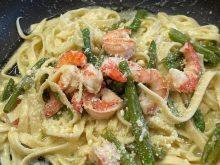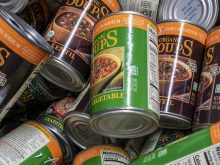One day, I heard a pop sound in my oven. When I turned it on, it appeared to be heating so I didn’t give it much thought.
A few days later, I was cooking a small turkey.
When I pulled it out to baste, the top was nice and brown and the bottom was raw. Apparently the lower oven element, which is concealed in the bottom of the oven, had burned out.
What to do with a half cooked turkey? Out to the barbecue I went. I turned the turkey upside down so the breast meat would not get overcooked.
Read Also

Fuel rebate rule change will affect taxes and AgriStability
The federal government recently announced updates to the fuel rebates that farmers have been receiving since 2019-20.
I added about half an inch (1 cm) of water to the pan to prevent the drippings from burning and fired up the natural gas barbecue.
With the barbecue set at 375 F (190 C), I put the turkey pan in the middle of the grill and closed the lid. I should have added a bit more water to the pan as the bottom of the pan had begun to scorch before I checked the turkey again.
Using a meat thermometer inserted in the underside of the breast, I took the turkey off the barbecue when the temperature reached 170 F (77 C). It was not the most attractive turkey, but it was moist, tasty and completely cooked.
Due to the pan scorching, the drippings could not be used to make gravy so I improvised with some canned chicken broth and poultry seasoning.
The Manitoba Turkey Producers recommend barbecuing a turkey between 325 F and 375 F (160 –190 C) with the barbecue lid closed and basting every 15 to 20 minutes, with the addition of more water to the pan as needed to prevent scorching.
After 20 to 30 minutes, lower the temperature to medium-low and tent the turkey with foil to prevent over-browning.
Cook until the internal temperature of the turkey reaches 179 F (77 C), then remove from the barbecue and let sit for 20 minutes before carving.
COFFEE CAKE ON THE BARBECUE
I had a yeast dough coffee cake rising when I discovered the oven malfunction so the cake was also cooked on the barbecue. I used the indirect method of grilling.
The burner beneath the food was turned off while the burners on either side, or on the opposite side of the food were turned on and adjusted to medium. I also placed two bricks, about two inches (5 cm) apart on the grill and put the cake pan on them.
I preheated the barbecue to 350 F (180 C) and carefully watched the temperature gauge to maintain this temperature.
Once the cake was on the barbecue, I didn’t open the lid until the cake was close to being cooked, to prevent heat fluctuations. Following the cake recipe directions, it cooked well and was a golden brown.
CRANBERRY BUNDT-STYLE COFFEE CAKE
This cake is made with a sweet slow-rise yeast dough. It can be mixed together up to two days ahead and allowed to slowly rise in the refrigerator, then baked just before serving. It also freezes well.
2 1/3 c. unbleached all purpose flour 575 mL
2 tbsp. sugar 30 mL
1 1/4 tsp. salt 6 mL
1 tsp. instant, fast-rising or bread machine yeast mL o
1/4 c. ice water 310 mL oi
l
5 tbsp. sugar 75 mL
1/3 c. instant non-fat dry 7 milk (don’t use a generic brand)5 mL mi tbsp. unsalted butter, 90 melted and cooled just slightly mL mellarge eggs, at room temperature, beaten
2/3 c. unbleached all 150 purpose flour mL purpeetened 375 mL cranberries
cranberries
1 tbspt 15 mL
1/2 c. chopped walnuts 125 mL or pecans (o or pecans (optional)ptional)0 mL all purpose floall purpose flour ur
1 mon 5 mL
1 tsp. ground coriander 5 mL
First Rise:
In a large bowl, stir the first amounts
of flour, sugar, sa and yeast. Vigorously stir in the water, scraping down the bowl and mixing until the dough is thoroughly blended.
If the mixture is too dry to incorporate the flour, add more water to blend the ingredients. If the mixture is soft, stir in more flour to make it firm, but not hard to stir.
Evenly brush the top lightly with oil. Tightly cover the bowl with plastic wrap. Refrigerate for three to four hours and let rise at cool room temperature for 12 to 18 hours.Second rise:
In a m
dium bowl, stir together the second amount of sugar, milk powder and butter, then mix in the eggs until well blended.
Gradually add the egg mixture, along with 2/3 cup (150 mL) flour, to the risen dough. Mix until the flour and egg mixture is evenly incorporated. This is more easily done with a dough hook and heavy-duty mixer on low. It will take several minutes.
Soak the cranberries in hot water for 10 minutes and drain well. (Reserve the juice to mix with fruit juice or some club soda.)
Add the cranberries and orange zest (and nuts, if using) into the dough until incorporated. In a small bowl, stir together the 1/4 cup (60 mL) flour and spices until well blended, then stir into the dough until blended. Stir in more flour if needed to yield a hard to stir, fairly stiff dough.
Turn dough into a well-oiled or nonstick spray coated eight to 10 cup (2 to 2 1/2 litre) bundt pan. Brush or spray the top with oil. Spread the dough and smooth out using an oiled rubber spatula. Tent the pan with nonstick spray-coated foil.
Let rise using any of the following rise methods:
Regular rise – let stand at a warm room temperature for two to three hours;
Accelerated rise – let stand in a turned off microwave along with one cup (250 mL) of boiling hot water for 1 1/2 to 2 1/2 hours;
Extended rise – refrigerate for four to 48 hours, then set out at room temperature.
If the dough nears the foil, remove it and continue the rise until the dough has doubled from its deflated size.
Traditional baking, place the oven rack in the lower third of the oven. Preheat the oven to 350 F (180 C). Bake 45 to 55 minutes, until the top is nicely browned; cover with foil partway through, if needed, to prevent over-browning.
Continue baking for five to 10 minutes more, or until a skewer inserted in the thickest part comes out with only a few particles on the end or the thickest part registers 205 to 207 F (96 –97 C) on an instant-read thermometer.
Then bake for another five minutes to ensure the bottom of the cake is done.
Cool in the pan on a wire rack for 15 minutes. Run a knife around the centre tube and sides to loosen the coffee cake, then invert it on cooling rack. Cool, then transfer to a serving plate.
Top the cooled coffee cake with sugar lemon drizzle.
The coffee cake slices best when cool but is good warm, at room temperature or toasted. Cool completely before storing. Keeps at room temperature for two to three days or may be frozen for up to two months.
SUGAR LEMON DRIZZLE
1 c. icing sugar 250 mL
1 1/2 tsp. fresh lemon juice 7 mL
2 tsp. water 10 mL
3 to 4 drops vanilla, almond or lemon extract
Measure the icing sugar, sifting if lumpy. In a small bowl, stir together the icing sugar, lemon juice, water and extract until blended and smooth. The glaze should be fluid enough to drizzle. Add a little more icing sugar or water if necessary. Immediately drizzle the glaze over the cooled cake, letting the icing drip attractively down the sides. The glaze will set up firm in about an hour.
Adapted from Kneadlessly Simple, Fabulous, Fuss-Free No-knead Breads by Nancy Baggett.
Father’s Day barbecue recipe contest
Are the men in your family the barbecue chefs? Here’s a chance for them to share their favourite recipes with our readers. Barbecue accessories will be awarded for the top three recipes. Look for these favourites in TEAM columns throughout the summer.
Submit your entries by May 31 to TEAM Barbecue Recipe Contest, Box 2500, Saskatoon, SK, S7K 2C4 or e-mail team@producer.com .
Betty Ann Deobald is a home economist from Rosetown, Sask., and a member of Team Resources. Contact: team@producer.com .














